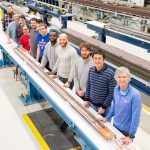The U.S. Department of Energy has approved the scope, cost and schedule for the U.S. LHC Accelerator Upgrade Project and has given the first approval for the purchase of materials. This project brings together scientists, engineers and technicians from national laboratories — such as Fermilab, Brookhaven, Berkeley, SLAC and Jefferson labs — to develop two cutting-edge technologies to advance the future of both the Large Hadron Collider and broader collider research.
Caitlyn Buongiorno
Caitlyn Buongiorno is a writer and social media manager in the Fermilab Office of Communication.
One sprinkle of sand at a time, two artists have recreated the moment a particle passed through a detector 30 years earlier. Their piece, a bright blue and white sculpture of tracks of microscopic bubbles in a bubble chamber, was inspired by the Tibetan Buddhist tradition of the sand mandala. To find the perfect bubble chamber image to recreate, they scrolled through hundreds of these photographs in the archive at Fermilab.


